Deployment of Machine Learning Techniques at JD: A Report
VerifiedAdded on 2022/10/11
|13
|3931
|14
Report
AI Summary
This report evaluates the effectiveness of Machine Learning (ML) techniques in enhancing the customer experience within JD, an online retail business. It begins with an executive summary and table of contents, followed by a definition of ML, differentiating it from Artificial Intelligence (AI) and highlighting their relationship. The report surveys ML applications across the manufacturing, pharmaceutical, and education industries, providing context. It then investigates how ML can be adopted in JD, focusing on the Human Resources and Customer Service departments, detailing potential benefits and limitations. Issues related to ML adoption, including ethical, legal, and social considerations, are discussed. The report concludes with recommendations for JD regarding ML implementation and a comprehensive reference list, offering valuable insights for stakeholders aiming to leverage ML for business improvement.
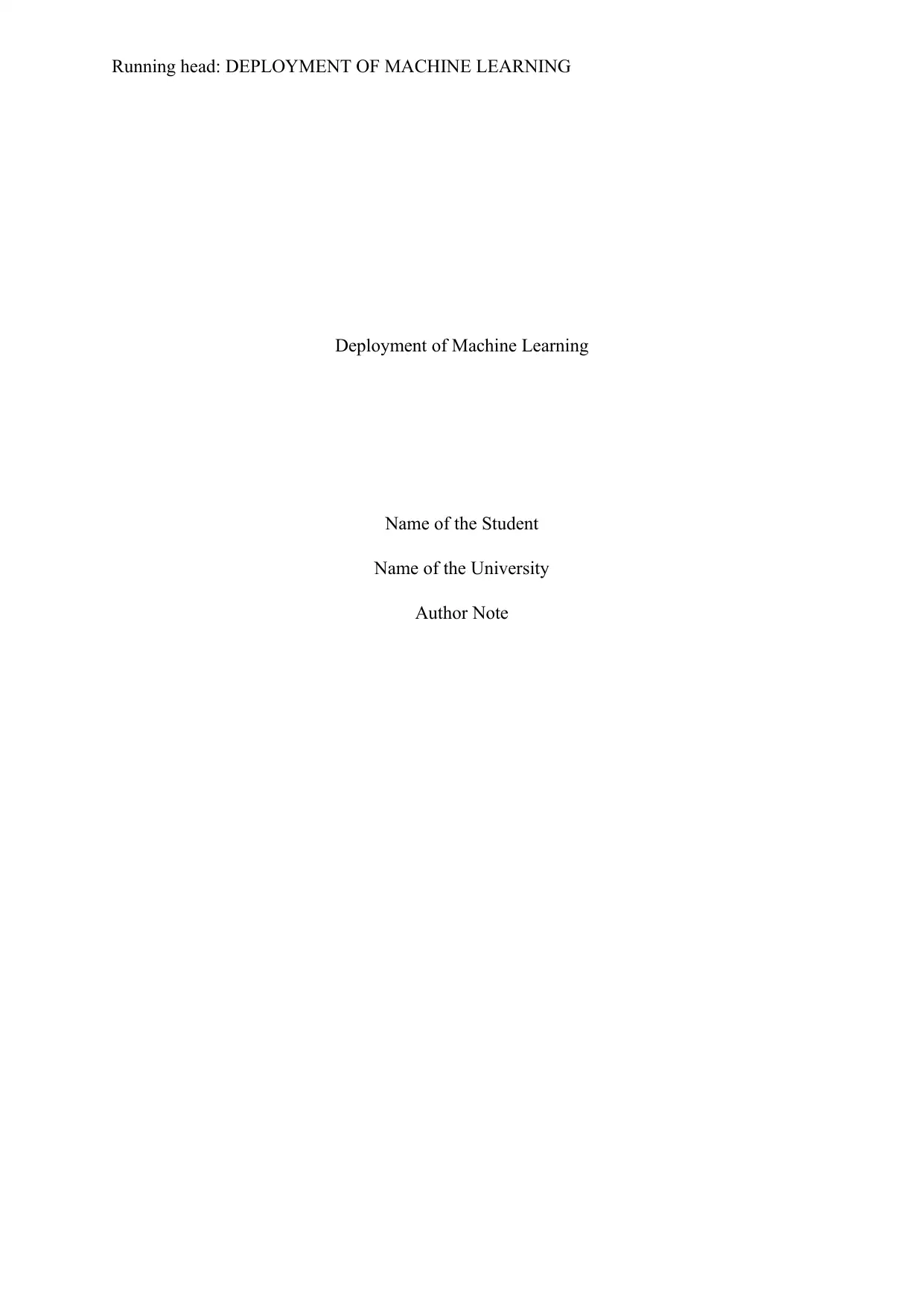
Running head: DEPLOYMENT OF MACHINE LEARNING
Deployment of Machine Learning
Name of the Student
Name of the University
Author Note
Deployment of Machine Learning
Name of the Student
Name of the University
Author Note
Paraphrase This Document
Need a fresh take? Get an instant paraphrase of this document with our AI Paraphraser
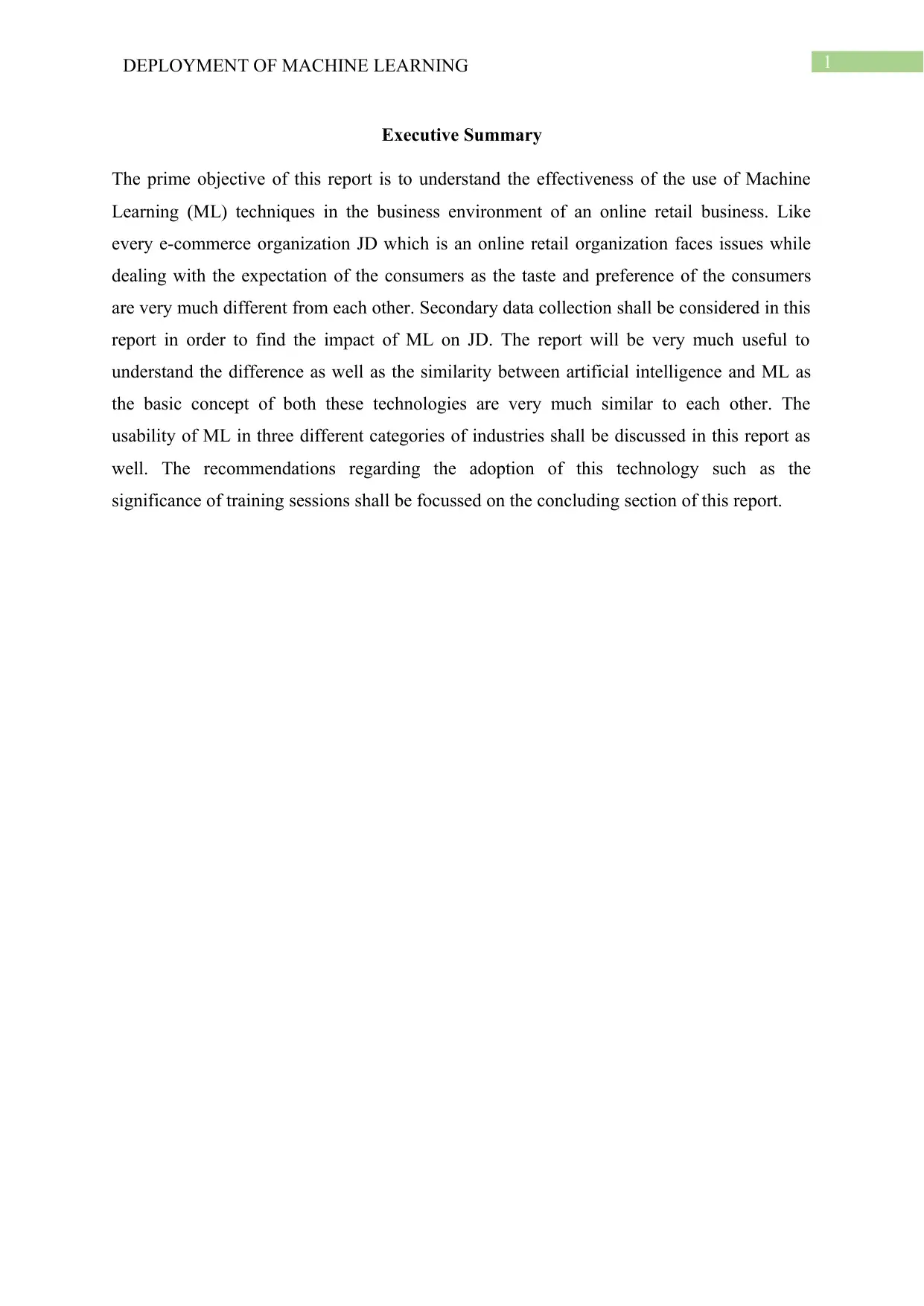
1DEPLOYMENT OF MACHINE LEARNING
Executive Summary
The prime objective of this report is to understand the effectiveness of the use of Machine
Learning (ML) techniques in the business environment of an online retail business. Like
every e-commerce organization JD which is an online retail organization faces issues while
dealing with the expectation of the consumers as the taste and preference of the consumers
are very much different from each other. Secondary data collection shall be considered in this
report in order to find the impact of ML on JD. The report will be very much useful to
understand the difference as well as the similarity between artificial intelligence and ML as
the basic concept of both these technologies are very much similar to each other. The
usability of ML in three different categories of industries shall be discussed in this report as
well. The recommendations regarding the adoption of this technology such as the
significance of training sessions shall be focussed on the concluding section of this report.
Executive Summary
The prime objective of this report is to understand the effectiveness of the use of Machine
Learning (ML) techniques in the business environment of an online retail business. Like
every e-commerce organization JD which is an online retail organization faces issues while
dealing with the expectation of the consumers as the taste and preference of the consumers
are very much different from each other. Secondary data collection shall be considered in this
report in order to find the impact of ML on JD. The report will be very much useful to
understand the difference as well as the similarity between artificial intelligence and ML as
the basic concept of both these technologies are very much similar to each other. The
usability of ML in three different categories of industries shall be discussed in this report as
well. The recommendations regarding the adoption of this technology such as the
significance of training sessions shall be focussed on the concluding section of this report.
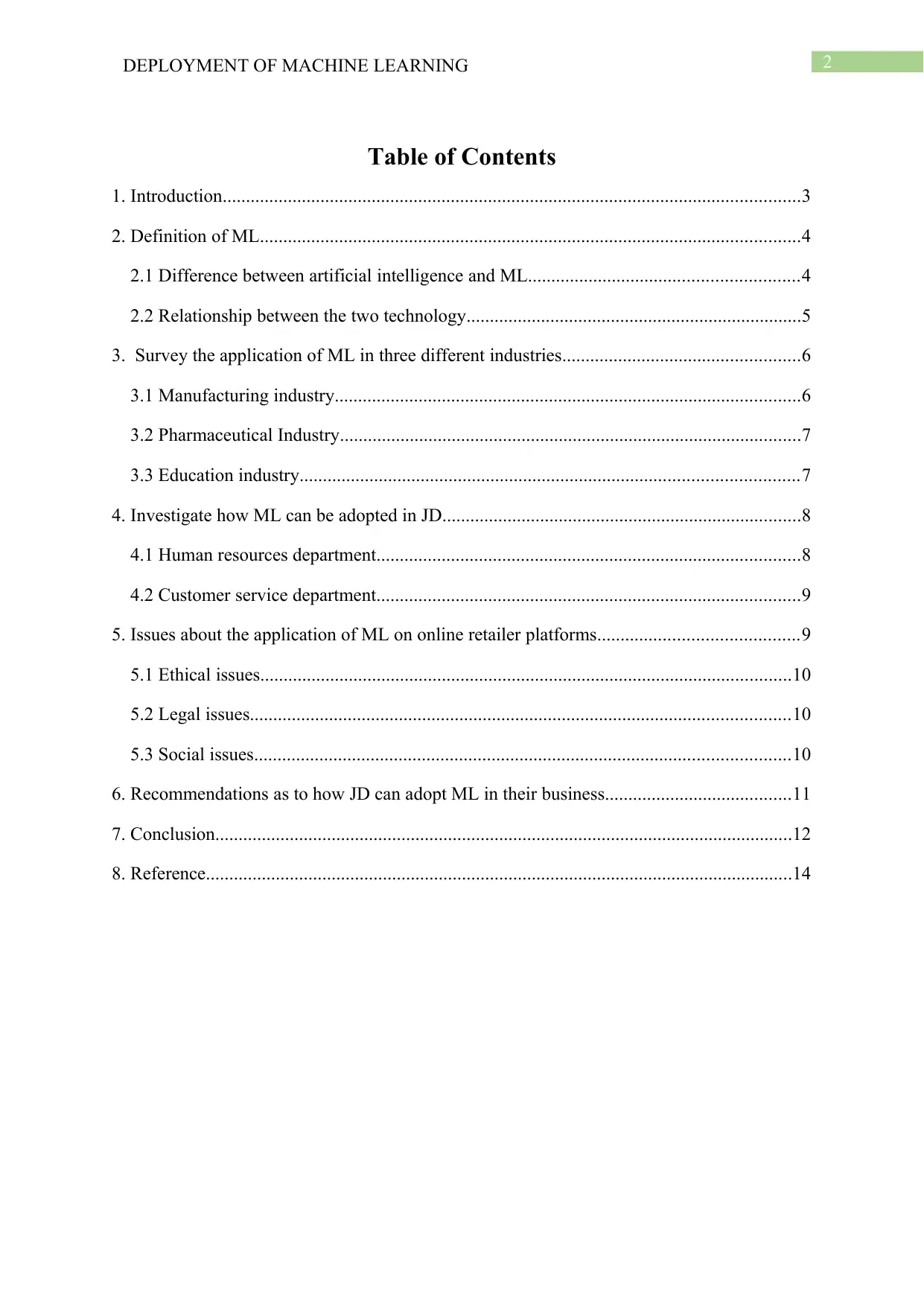
2DEPLOYMENT OF MACHINE LEARNING
Table of Contents
1. Introduction............................................................................................................................3
2. Definition of ML....................................................................................................................4
2.1 Difference between artificial intelligence and ML..........................................................4
2.2 Relationship between the two technology........................................................................5
3. Survey the application of ML in three different industries...................................................6
3.1 Manufacturing industry....................................................................................................6
3.2 Pharmaceutical Industry...................................................................................................7
3.3 Education industry...........................................................................................................7
4. Investigate how ML can be adopted in JD.............................................................................8
4.1 Human resources department...........................................................................................8
4.2 Customer service department...........................................................................................9
5. Issues about the application of ML on online retailer platforms...........................................9
5.1 Ethical issues..................................................................................................................10
5.2 Legal issues....................................................................................................................10
5.3 Social issues...................................................................................................................10
6. Recommendations as to how JD can adopt ML in their business........................................11
7. Conclusion............................................................................................................................12
8. Reference..............................................................................................................................14
Table of Contents
1. Introduction............................................................................................................................3
2. Definition of ML....................................................................................................................4
2.1 Difference between artificial intelligence and ML..........................................................4
2.2 Relationship between the two technology........................................................................5
3. Survey the application of ML in three different industries...................................................6
3.1 Manufacturing industry....................................................................................................6
3.2 Pharmaceutical Industry...................................................................................................7
3.3 Education industry...........................................................................................................7
4. Investigate how ML can be adopted in JD.............................................................................8
4.1 Human resources department...........................................................................................8
4.2 Customer service department...........................................................................................9
5. Issues about the application of ML on online retailer platforms...........................................9
5.1 Ethical issues..................................................................................................................10
5.2 Legal issues....................................................................................................................10
5.3 Social issues...................................................................................................................10
6. Recommendations as to how JD can adopt ML in their business........................................11
7. Conclusion............................................................................................................................12
8. Reference..............................................................................................................................14
⊘ This is a preview!⊘
Do you want full access?
Subscribe today to unlock all pages.

Trusted by 1+ million students worldwide
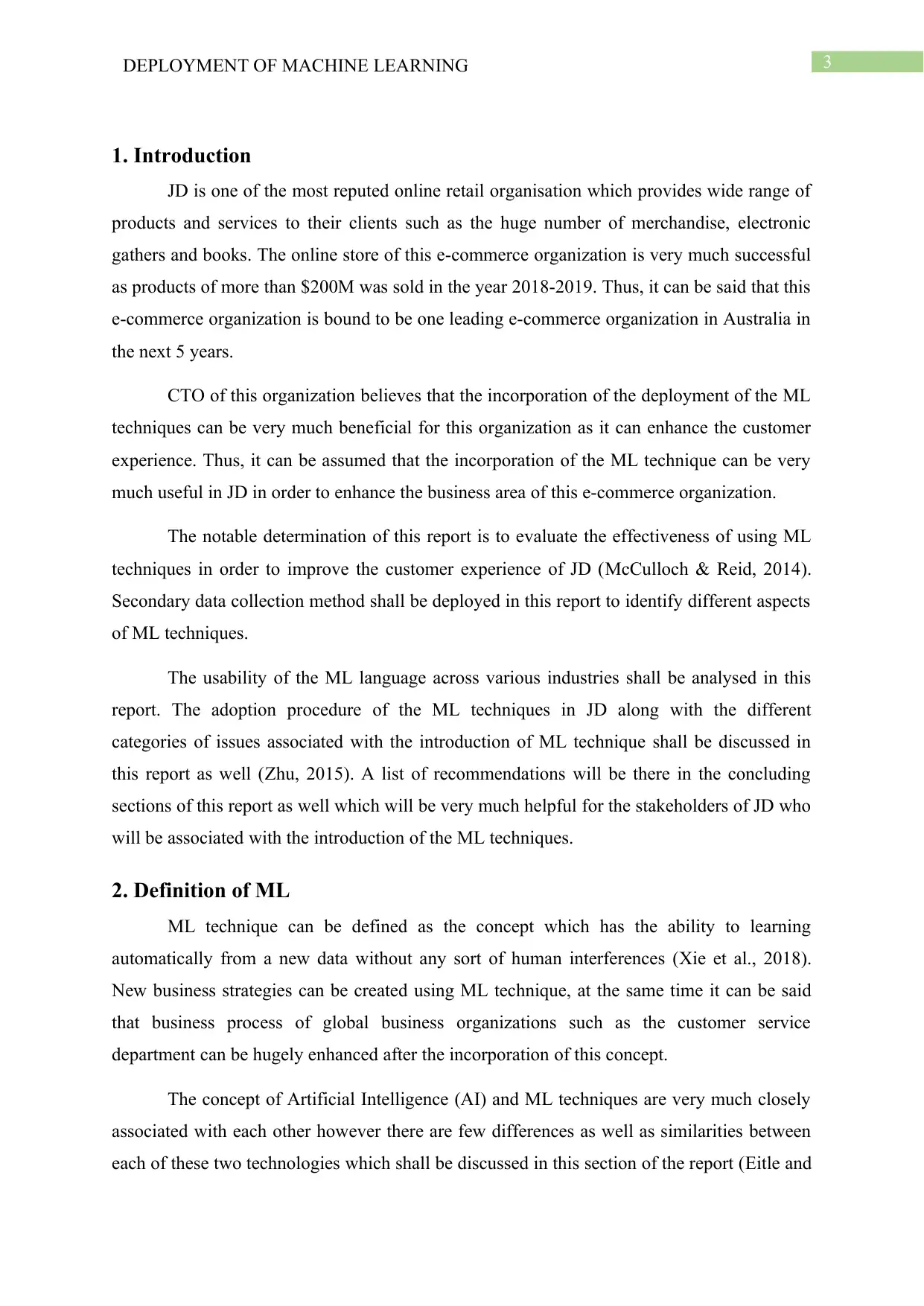
3DEPLOYMENT OF MACHINE LEARNING
1. Introduction
JD is one of the most reputed online retail organisation which provides wide range of
products and services to their clients such as the huge number of merchandise, electronic
gathers and books. The online store of this e-commerce organization is very much successful
as products of more than $200M was sold in the year 2018-2019. Thus, it can be said that this
e-commerce organization is bound to be one leading e-commerce organization in Australia in
the next 5 years.
CTO of this organization believes that the incorporation of the deployment of the ML
techniques can be very much beneficial for this organization as it can enhance the customer
experience. Thus, it can be assumed that the incorporation of the ML technique can be very
much useful in JD in order to enhance the business area of this e-commerce organization.
The notable determination of this report is to evaluate the effectiveness of using ML
techniques in order to improve the customer experience of JD (McCulloch & Reid, 2014).
Secondary data collection method shall be deployed in this report to identify different aspects
of ML techniques.
The usability of the ML language across various industries shall be analysed in this
report. The adoption procedure of the ML techniques in JD along with the different
categories of issues associated with the introduction of ML technique shall be discussed in
this report as well (Zhu, 2015). A list of recommendations will be there in the concluding
sections of this report as well which will be very much helpful for the stakeholders of JD who
will be associated with the introduction of the ML techniques.
2. Definition of ML
ML technique can be defined as the concept which has the ability to learning
automatically from a new data without any sort of human interferences (Xie et al., 2018).
New business strategies can be created using ML technique, at the same time it can be said
that business process of global business organizations such as the customer service
department can be hugely enhanced after the incorporation of this concept.
The concept of Artificial Intelligence (AI) and ML techniques are very much closely
associated with each other however there are few differences as well as similarities between
each of these two technologies which shall be discussed in this section of the report (Eitle and
1. Introduction
JD is one of the most reputed online retail organisation which provides wide range of
products and services to their clients such as the huge number of merchandise, electronic
gathers and books. The online store of this e-commerce organization is very much successful
as products of more than $200M was sold in the year 2018-2019. Thus, it can be said that this
e-commerce organization is bound to be one leading e-commerce organization in Australia in
the next 5 years.
CTO of this organization believes that the incorporation of the deployment of the ML
techniques can be very much beneficial for this organization as it can enhance the customer
experience. Thus, it can be assumed that the incorporation of the ML technique can be very
much useful in JD in order to enhance the business area of this e-commerce organization.
The notable determination of this report is to evaluate the effectiveness of using ML
techniques in order to improve the customer experience of JD (McCulloch & Reid, 2014).
Secondary data collection method shall be deployed in this report to identify different aspects
of ML techniques.
The usability of the ML language across various industries shall be analysed in this
report. The adoption procedure of the ML techniques in JD along with the different
categories of issues associated with the introduction of ML technique shall be discussed in
this report as well (Zhu, 2015). A list of recommendations will be there in the concluding
sections of this report as well which will be very much helpful for the stakeholders of JD who
will be associated with the introduction of the ML techniques.
2. Definition of ML
ML technique can be defined as the concept which has the ability to learning
automatically from a new data without any sort of human interferences (Xie et al., 2018).
New business strategies can be created using ML technique, at the same time it can be said
that business process of global business organizations such as the customer service
department can be hugely enhanced after the incorporation of this concept.
The concept of Artificial Intelligence (AI) and ML techniques are very much closely
associated with each other however there are few differences as well as similarities between
each of these two technologies which shall be discussed in this section of the report (Eitle and
Paraphrase This Document
Need a fresh take? Get an instant paraphrase of this document with our AI Paraphraser
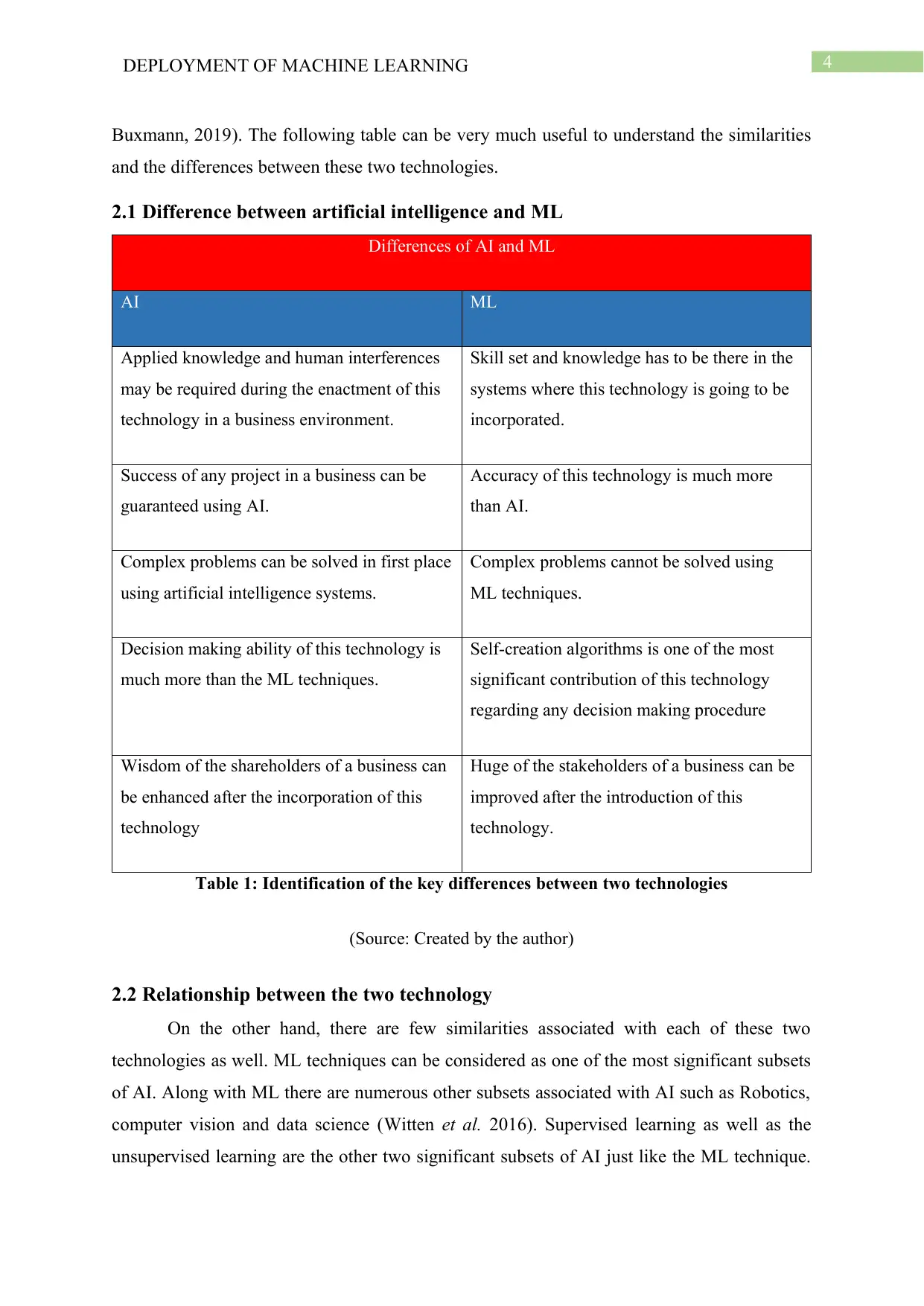
4DEPLOYMENT OF MACHINE LEARNING
Buxmann, 2019). The following table can be very much useful to understand the similarities
and the differences between these two technologies.
2.1 Difference between artificial intelligence and ML
Differences of AI and ML
AI ML
Applied knowledge and human interferences
may be required during the enactment of this
technology in a business environment.
Skill set and knowledge has to be there in the
systems where this technology is going to be
incorporated.
Success of any project in a business can be
guaranteed using AI.
Accuracy of this technology is much more
than AI.
Complex problems can be solved in first place
using artificial intelligence systems.
Complex problems cannot be solved using
ML techniques.
Decision making ability of this technology is
much more than the ML techniques.
Self-creation algorithms is one of the most
significant contribution of this technology
regarding any decision making procedure
Wisdom of the shareholders of a business can
be enhanced after the incorporation of this
technology
Huge of the stakeholders of a business can be
improved after the introduction of this
technology.
Table 1: Identification of the key differences between two technologies
(Source: Created by the author)
2.2 Relationship between the two technology
On the other hand, there are few similarities associated with each of these two
technologies as well. ML techniques can be considered as one of the most significant subsets
of AI. Along with ML there are numerous other subsets associated with AI such as Robotics,
computer vision and data science (Witten et al. 2016). Supervised learning as well as the
unsupervised learning are the other two significant subsets of AI just like the ML technique.
Buxmann, 2019). The following table can be very much useful to understand the similarities
and the differences between these two technologies.
2.1 Difference between artificial intelligence and ML
Differences of AI and ML
AI ML
Applied knowledge and human interferences
may be required during the enactment of this
technology in a business environment.
Skill set and knowledge has to be there in the
systems where this technology is going to be
incorporated.
Success of any project in a business can be
guaranteed using AI.
Accuracy of this technology is much more
than AI.
Complex problems can be solved in first place
using artificial intelligence systems.
Complex problems cannot be solved using
ML techniques.
Decision making ability of this technology is
much more than the ML techniques.
Self-creation algorithms is one of the most
significant contribution of this technology
regarding any decision making procedure
Wisdom of the shareholders of a business can
be enhanced after the incorporation of this
technology
Huge of the stakeholders of a business can be
improved after the introduction of this
technology.
Table 1: Identification of the key differences between two technologies
(Source: Created by the author)
2.2 Relationship between the two technology
On the other hand, there are few similarities associated with each of these two
technologies as well. ML techniques can be considered as one of the most significant subsets
of AI. Along with ML there are numerous other subsets associated with AI such as Robotics,
computer vision and data science (Witten et al. 2016). Supervised learning as well as the
unsupervised learning are the other two significant subsets of AI just like the ML technique.
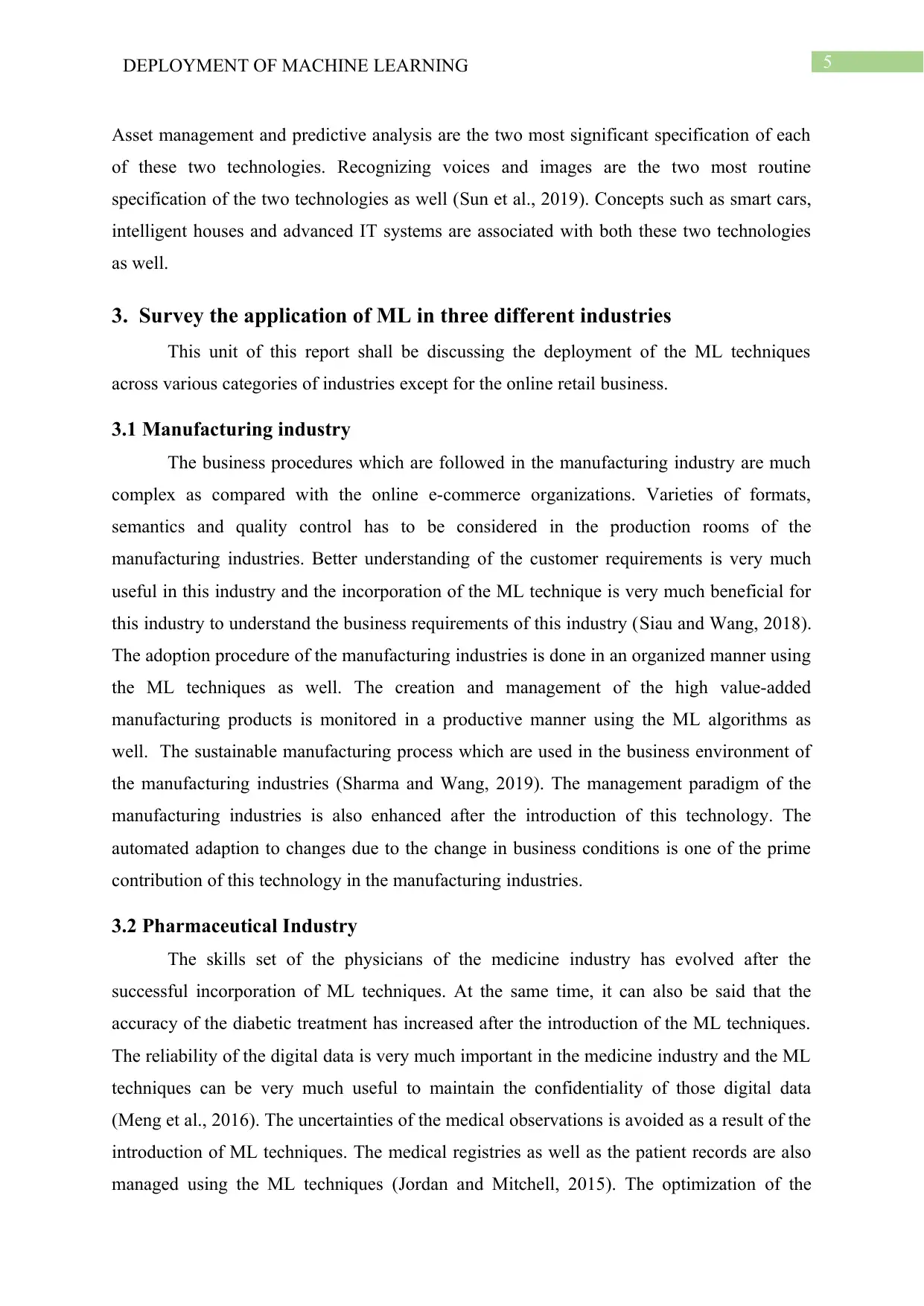
5DEPLOYMENT OF MACHINE LEARNING
Asset management and predictive analysis are the two most significant specification of each
of these two technologies. Recognizing voices and images are the two most routine
specification of the two technologies as well (Sun et al., 2019). Concepts such as smart cars,
intelligent houses and advanced IT systems are associated with both these two technologies
as well.
3. Survey the application of ML in three different industries
This unit of this report shall be discussing the deployment of the ML techniques
across various categories of industries except for the online retail business.
3.1 Manufacturing industry
The business procedures which are followed in the manufacturing industry are much
complex as compared with the online e-commerce organizations. Varieties of formats,
semantics and quality control has to be considered in the production rooms of the
manufacturing industries. Better understanding of the customer requirements is very much
useful in this industry and the incorporation of the ML technique is very much beneficial for
this industry to understand the business requirements of this industry (Siau and Wang, 2018).
The adoption procedure of the manufacturing industries is done in an organized manner using
the ML techniques as well. The creation and management of the high value-added
manufacturing products is monitored in a productive manner using the ML algorithms as
well. The sustainable manufacturing process which are used in the business environment of
the manufacturing industries (Sharma and Wang, 2019). The management paradigm of the
manufacturing industries is also enhanced after the introduction of this technology. The
automated adaption to changes due to the change in business conditions is one of the prime
contribution of this technology in the manufacturing industries.
3.2 Pharmaceutical Industry
The skills set of the physicians of the medicine industry has evolved after the
successful incorporation of ML techniques. At the same time, it can also be said that the
accuracy of the diabetic treatment has increased after the introduction of the ML techniques.
The reliability of the digital data is very much important in the medicine industry and the ML
techniques can be very much useful to maintain the confidentiality of those digital data
(Meng et al., 2016). The uncertainties of the medical observations is avoided as a result of the
introduction of ML techniques. The medical registries as well as the patient records are also
managed using the ML techniques (Jordan and Mitchell, 2015). The optimization of the
Asset management and predictive analysis are the two most significant specification of each
of these two technologies. Recognizing voices and images are the two most routine
specification of the two technologies as well (Sun et al., 2019). Concepts such as smart cars,
intelligent houses and advanced IT systems are associated with both these two technologies
as well.
3. Survey the application of ML in three different industries
This unit of this report shall be discussing the deployment of the ML techniques
across various categories of industries except for the online retail business.
3.1 Manufacturing industry
The business procedures which are followed in the manufacturing industry are much
complex as compared with the online e-commerce organizations. Varieties of formats,
semantics and quality control has to be considered in the production rooms of the
manufacturing industries. Better understanding of the customer requirements is very much
useful in this industry and the incorporation of the ML technique is very much beneficial for
this industry to understand the business requirements of this industry (Siau and Wang, 2018).
The adoption procedure of the manufacturing industries is done in an organized manner using
the ML techniques as well. The creation and management of the high value-added
manufacturing products is monitored in a productive manner using the ML algorithms as
well. The sustainable manufacturing process which are used in the business environment of
the manufacturing industries (Sharma and Wang, 2019). The management paradigm of the
manufacturing industries is also enhanced after the introduction of this technology. The
automated adaption to changes due to the change in business conditions is one of the prime
contribution of this technology in the manufacturing industries.
3.2 Pharmaceutical Industry
The skills set of the physicians of the medicine industry has evolved after the
successful incorporation of ML techniques. At the same time, it can also be said that the
accuracy of the diabetic treatment has increased after the introduction of the ML techniques.
The reliability of the digital data is very much important in the medicine industry and the ML
techniques can be very much useful to maintain the confidentiality of those digital data
(Meng et al., 2016). The uncertainties of the medical observations is avoided as a result of the
introduction of ML techniques. The medical registries as well as the patient records are also
managed using the ML techniques (Jordan and Mitchell, 2015). The optimization of the
⊘ This is a preview!⊘
Do you want full access?
Subscribe today to unlock all pages.

Trusted by 1+ million students worldwide
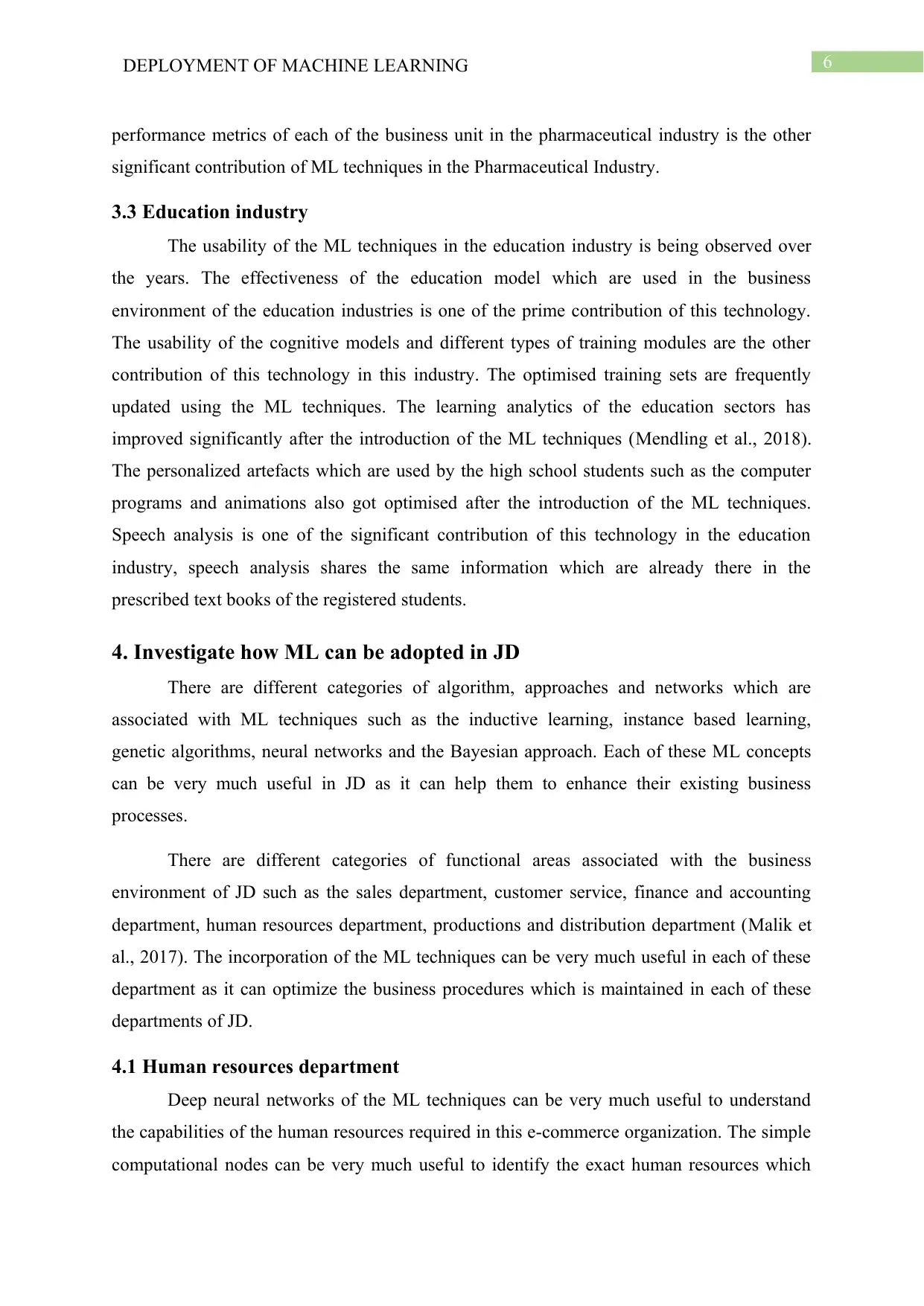
6DEPLOYMENT OF MACHINE LEARNING
performance metrics of each of the business unit in the pharmaceutical industry is the other
significant contribution of ML techniques in the Pharmaceutical Industry.
3.3 Education industry
The usability of the ML techniques in the education industry is being observed over
the years. The effectiveness of the education model which are used in the business
environment of the education industries is one of the prime contribution of this technology.
The usability of the cognitive models and different types of training modules are the other
contribution of this technology in this industry. The optimised training sets are frequently
updated using the ML techniques. The learning analytics of the education sectors has
improved significantly after the introduction of the ML techniques (Mendling et al., 2018).
The personalized artefacts which are used by the high school students such as the computer
programs and animations also got optimised after the introduction of the ML techniques.
Speech analysis is one of the significant contribution of this technology in the education
industry, speech analysis shares the same information which are already there in the
prescribed text books of the registered students.
4. Investigate how ML can be adopted in JD
There are different categories of algorithm, approaches and networks which are
associated with ML techniques such as the inductive learning, instance based learning,
genetic algorithms, neural networks and the Bayesian approach. Each of these ML concepts
can be very much useful in JD as it can help them to enhance their existing business
processes.
There are different categories of functional areas associated with the business
environment of JD such as the sales department, customer service, finance and accounting
department, human resources department, productions and distribution department (Malik et
al., 2017). The incorporation of the ML techniques can be very much useful in each of these
department as it can optimize the business procedures which is maintained in each of these
departments of JD.
4.1 Human resources department
Deep neural networks of the ML techniques can be very much useful to understand
the capabilities of the human resources required in this e-commerce organization. The simple
computational nodes can be very much useful to identify the exact human resources which
performance metrics of each of the business unit in the pharmaceutical industry is the other
significant contribution of ML techniques in the Pharmaceutical Industry.
3.3 Education industry
The usability of the ML techniques in the education industry is being observed over
the years. The effectiveness of the education model which are used in the business
environment of the education industries is one of the prime contribution of this technology.
The usability of the cognitive models and different types of training modules are the other
contribution of this technology in this industry. The optimised training sets are frequently
updated using the ML techniques. The learning analytics of the education sectors has
improved significantly after the introduction of the ML techniques (Mendling et al., 2018).
The personalized artefacts which are used by the high school students such as the computer
programs and animations also got optimised after the introduction of the ML techniques.
Speech analysis is one of the significant contribution of this technology in the education
industry, speech analysis shares the same information which are already there in the
prescribed text books of the registered students.
4. Investigate how ML can be adopted in JD
There are different categories of algorithm, approaches and networks which are
associated with ML techniques such as the inductive learning, instance based learning,
genetic algorithms, neural networks and the Bayesian approach. Each of these ML concepts
can be very much useful in JD as it can help them to enhance their existing business
processes.
There are different categories of functional areas associated with the business
environment of JD such as the sales department, customer service, finance and accounting
department, human resources department, productions and distribution department (Malik et
al., 2017). The incorporation of the ML techniques can be very much useful in each of these
department as it can optimize the business procedures which is maintained in each of these
departments of JD.
4.1 Human resources department
Deep neural networks of the ML techniques can be very much useful to understand
the capabilities of the human resources required in this e-commerce organization. The simple
computational nodes can be very much useful to identify the exact human resources which
Paraphrase This Document
Need a fresh take? Get an instant paraphrase of this document with our AI Paraphraser
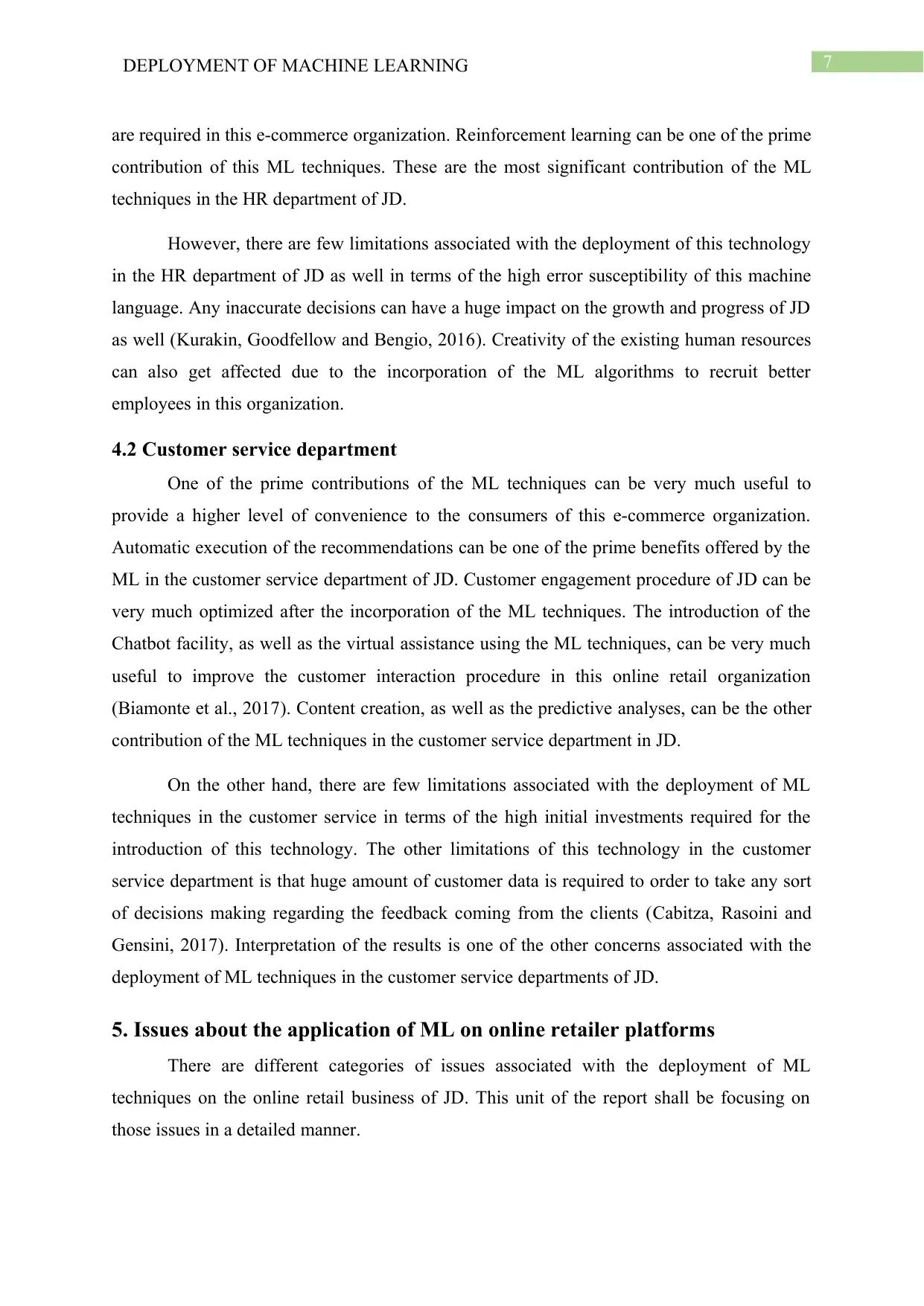
7DEPLOYMENT OF MACHINE LEARNING
are required in this e-commerce organization. Reinforcement learning can be one of the prime
contribution of this ML techniques. These are the most significant contribution of the ML
techniques in the HR department of JD.
However, there are few limitations associated with the deployment of this technology
in the HR department of JD as well in terms of the high error susceptibility of this machine
language. Any inaccurate decisions can have a huge impact on the growth and progress of JD
as well (Kurakin, Goodfellow and Bengio, 2016). Creativity of the existing human resources
can also get affected due to the incorporation of the ML algorithms to recruit better
employees in this organization.
4.2 Customer service department
One of the prime contributions of the ML techniques can be very much useful to
provide a higher level of convenience to the consumers of this e-commerce organization.
Automatic execution of the recommendations can be one of the prime benefits offered by the
ML in the customer service department of JD. Customer engagement procedure of JD can be
very much optimized after the incorporation of the ML techniques. The introduction of the
Chatbot facility, as well as the virtual assistance using the ML techniques, can be very much
useful to improve the customer interaction procedure in this online retail organization
(Biamonte et al., 2017). Content creation, as well as the predictive analyses, can be the other
contribution of the ML techniques in the customer service department in JD.
On the other hand, there are few limitations associated with the deployment of ML
techniques in the customer service in terms of the high initial investments required for the
introduction of this technology. The other limitations of this technology in the customer
service department is that huge amount of customer data is required to order to take any sort
of decisions making regarding the feedback coming from the clients (Cabitza, Rasoini and
Gensini, 2017). Interpretation of the results is one of the other concerns associated with the
deployment of ML techniques in the customer service departments of JD.
5. Issues about the application of ML on online retailer platforms
There are different categories of issues associated with the deployment of ML
techniques on the online retail business of JD. This unit of the report shall be focusing on
those issues in a detailed manner.
are required in this e-commerce organization. Reinforcement learning can be one of the prime
contribution of this ML techniques. These are the most significant contribution of the ML
techniques in the HR department of JD.
However, there are few limitations associated with the deployment of this technology
in the HR department of JD as well in terms of the high error susceptibility of this machine
language. Any inaccurate decisions can have a huge impact on the growth and progress of JD
as well (Kurakin, Goodfellow and Bengio, 2016). Creativity of the existing human resources
can also get affected due to the incorporation of the ML algorithms to recruit better
employees in this organization.
4.2 Customer service department
One of the prime contributions of the ML techniques can be very much useful to
provide a higher level of convenience to the consumers of this e-commerce organization.
Automatic execution of the recommendations can be one of the prime benefits offered by the
ML in the customer service department of JD. Customer engagement procedure of JD can be
very much optimized after the incorporation of the ML techniques. The introduction of the
Chatbot facility, as well as the virtual assistance using the ML techniques, can be very much
useful to improve the customer interaction procedure in this online retail organization
(Biamonte et al., 2017). Content creation, as well as the predictive analyses, can be the other
contribution of the ML techniques in the customer service department in JD.
On the other hand, there are few limitations associated with the deployment of ML
techniques in the customer service in terms of the high initial investments required for the
introduction of this technology. The other limitations of this technology in the customer
service department is that huge amount of customer data is required to order to take any sort
of decisions making regarding the feedback coming from the clients (Cabitza, Rasoini and
Gensini, 2017). Interpretation of the results is one of the other concerns associated with the
deployment of ML techniques in the customer service departments of JD.
5. Issues about the application of ML on online retailer platforms
There are different categories of issues associated with the deployment of ML
techniques on the online retail business of JD. This unit of the report shall be focusing on
those issues in a detailed manner.
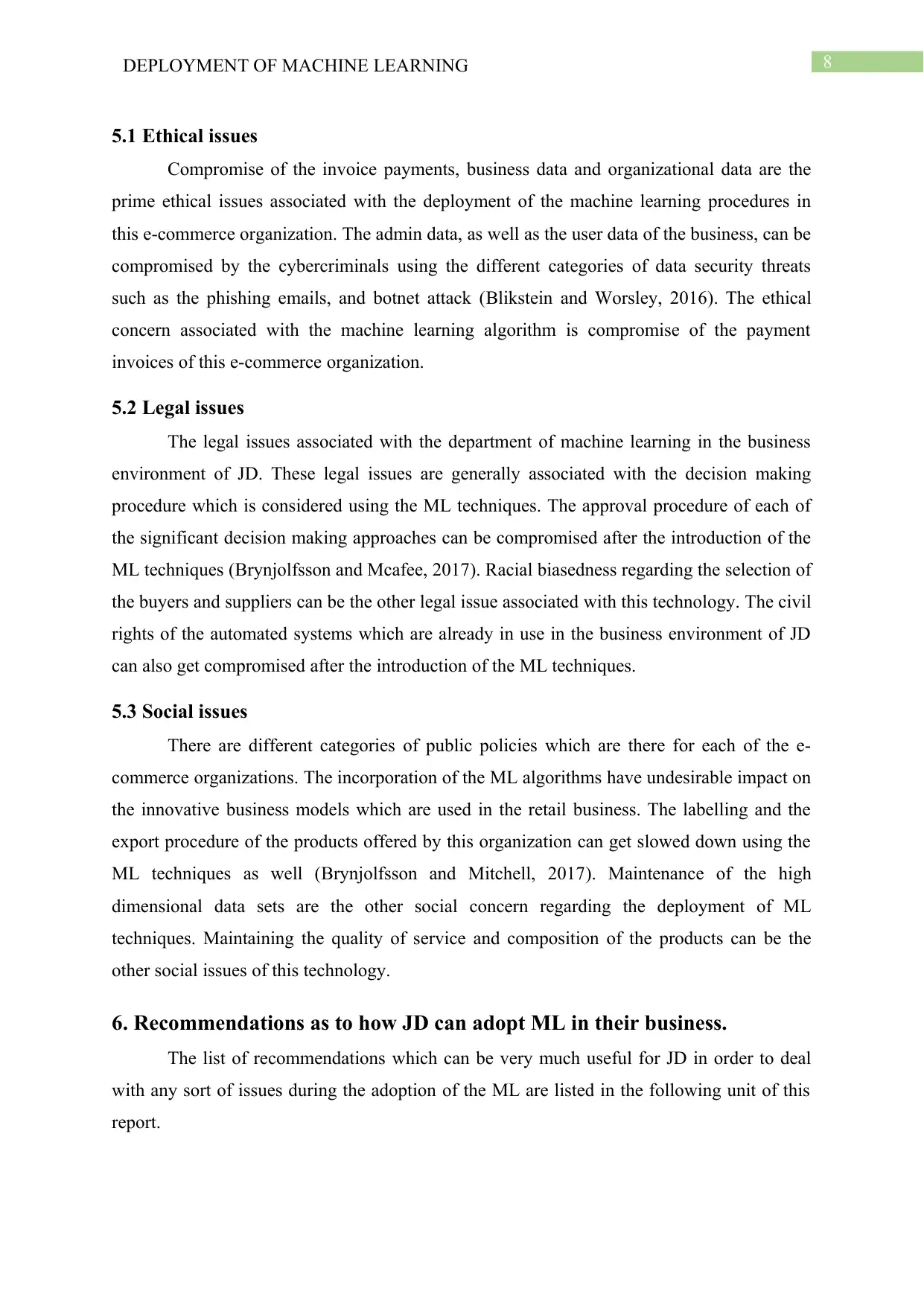
8DEPLOYMENT OF MACHINE LEARNING
5.1 Ethical issues
Compromise of the invoice payments, business data and organizational data are the
prime ethical issues associated with the deployment of the machine learning procedures in
this e-commerce organization. The admin data, as well as the user data of the business, can be
compromised by the cybercriminals using the different categories of data security threats
such as the phishing emails, and botnet attack (Blikstein and Worsley, 2016). The ethical
concern associated with the machine learning algorithm is compromise of the payment
invoices of this e-commerce organization.
5.2 Legal issues
The legal issues associated with the department of machine learning in the business
environment of JD. These legal issues are generally associated with the decision making
procedure which is considered using the ML techniques. The approval procedure of each of
the significant decision making approaches can be compromised after the introduction of the
ML techniques (Brynjolfsson and Mcafee, 2017). Racial biasedness regarding the selection of
the buyers and suppliers can be the other legal issue associated with this technology. The civil
rights of the automated systems which are already in use in the business environment of JD
can also get compromised after the introduction of the ML techniques.
5.3 Social issues
There are different categories of public policies which are there for each of the e-
commerce organizations. The incorporation of the ML algorithms have undesirable impact on
the innovative business models which are used in the retail business. The labelling and the
export procedure of the products offered by this organization can get slowed down using the
ML techniques as well (Brynjolfsson and Mitchell, 2017). Maintenance of the high
dimensional data sets are the other social concern regarding the deployment of ML
techniques. Maintaining the quality of service and composition of the products can be the
other social issues of this technology.
6. Recommendations as to how JD can adopt ML in their business.
The list of recommendations which can be very much useful for JD in order to deal
with any sort of issues during the adoption of the ML are listed in the following unit of this
report.
5.1 Ethical issues
Compromise of the invoice payments, business data and organizational data are the
prime ethical issues associated with the deployment of the machine learning procedures in
this e-commerce organization. The admin data, as well as the user data of the business, can be
compromised by the cybercriminals using the different categories of data security threats
such as the phishing emails, and botnet attack (Blikstein and Worsley, 2016). The ethical
concern associated with the machine learning algorithm is compromise of the payment
invoices of this e-commerce organization.
5.2 Legal issues
The legal issues associated with the department of machine learning in the business
environment of JD. These legal issues are generally associated with the decision making
procedure which is considered using the ML techniques. The approval procedure of each of
the significant decision making approaches can be compromised after the introduction of the
ML techniques (Brynjolfsson and Mcafee, 2017). Racial biasedness regarding the selection of
the buyers and suppliers can be the other legal issue associated with this technology. The civil
rights of the automated systems which are already in use in the business environment of JD
can also get compromised after the introduction of the ML techniques.
5.3 Social issues
There are different categories of public policies which are there for each of the e-
commerce organizations. The incorporation of the ML algorithms have undesirable impact on
the innovative business models which are used in the retail business. The labelling and the
export procedure of the products offered by this organization can get slowed down using the
ML techniques as well (Brynjolfsson and Mitchell, 2017). Maintenance of the high
dimensional data sets are the other social concern regarding the deployment of ML
techniques. Maintaining the quality of service and composition of the products can be the
other social issues of this technology.
6. Recommendations as to how JD can adopt ML in their business.
The list of recommendations which can be very much useful for JD in order to deal
with any sort of issues during the adoption of the ML are listed in the following unit of this
report.
⊘ This is a preview!⊘
Do you want full access?
Subscribe today to unlock all pages.

Trusted by 1+ million students worldwide
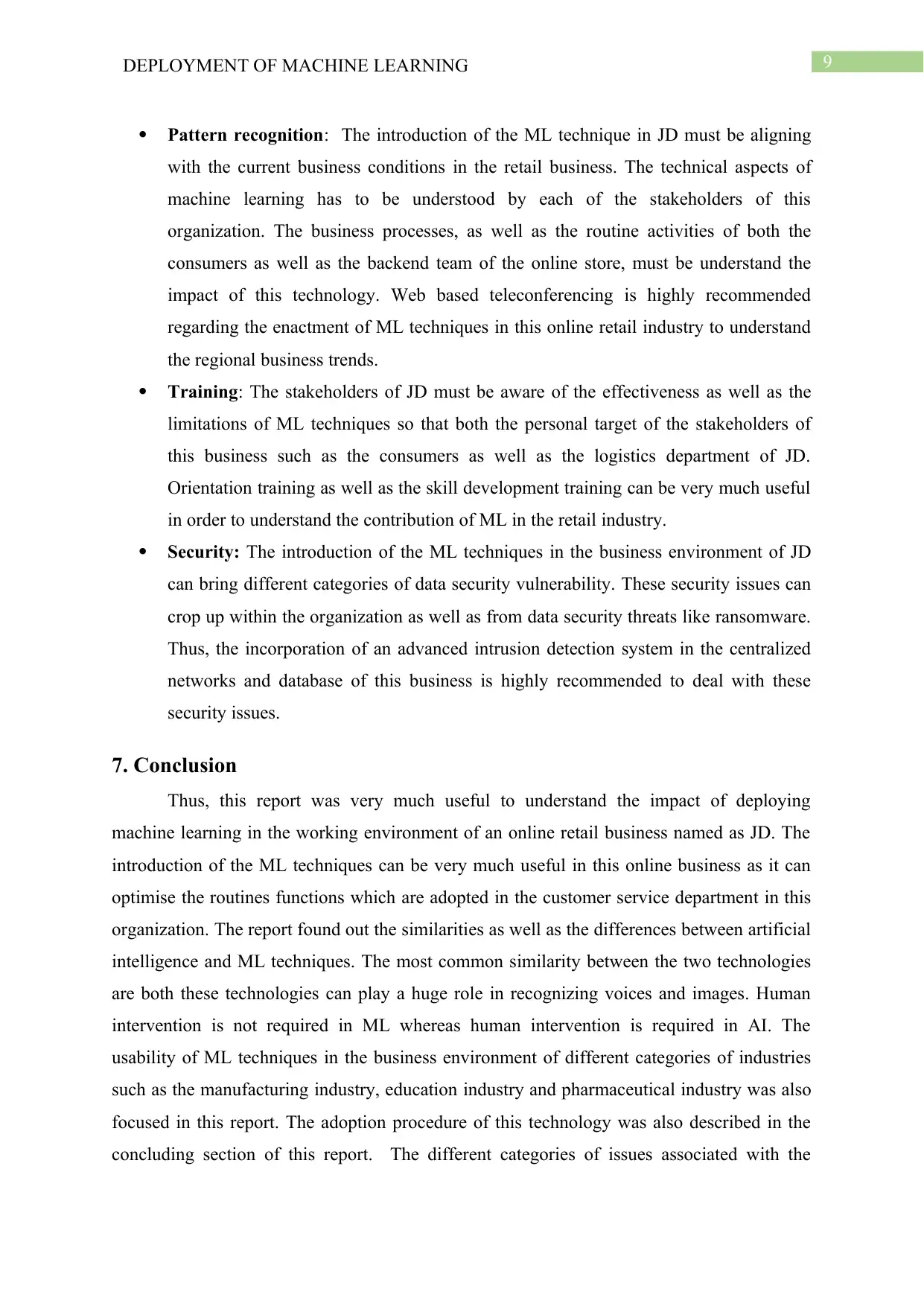
9DEPLOYMENT OF MACHINE LEARNING
Pattern recognition: The introduction of the ML technique in JD must be aligning
with the current business conditions in the retail business. The technical aspects of
machine learning has to be understood by each of the stakeholders of this
organization. The business processes, as well as the routine activities of both the
consumers as well as the backend team of the online store, must be understand the
impact of this technology. Web based teleconferencing is highly recommended
regarding the enactment of ML techniques in this online retail industry to understand
the regional business trends.
Training: The stakeholders of JD must be aware of the effectiveness as well as the
limitations of ML techniques so that both the personal target of the stakeholders of
this business such as the consumers as well as the logistics department of JD.
Orientation training as well as the skill development training can be very much useful
in order to understand the contribution of ML in the retail industry.
Security: The introduction of the ML techniques in the business environment of JD
can bring different categories of data security vulnerability. These security issues can
crop up within the organization as well as from data security threats like ransomware.
Thus, the incorporation of an advanced intrusion detection system in the centralized
networks and database of this business is highly recommended to deal with these
security issues.
7. Conclusion
Thus, this report was very much useful to understand the impact of deploying
machine learning in the working environment of an online retail business named as JD. The
introduction of the ML techniques can be very much useful in this online business as it can
optimise the routines functions which are adopted in the customer service department in this
organization. The report found out the similarities as well as the differences between artificial
intelligence and ML techniques. The most common similarity between the two technologies
are both these technologies can play a huge role in recognizing voices and images. Human
intervention is not required in ML whereas human intervention is required in AI. The
usability of ML techniques in the business environment of different categories of industries
such as the manufacturing industry, education industry and pharmaceutical industry was also
focused in this report. The adoption procedure of this technology was also described in the
concluding section of this report. The different categories of issues associated with the
Pattern recognition: The introduction of the ML technique in JD must be aligning
with the current business conditions in the retail business. The technical aspects of
machine learning has to be understood by each of the stakeholders of this
organization. The business processes, as well as the routine activities of both the
consumers as well as the backend team of the online store, must be understand the
impact of this technology. Web based teleconferencing is highly recommended
regarding the enactment of ML techniques in this online retail industry to understand
the regional business trends.
Training: The stakeholders of JD must be aware of the effectiveness as well as the
limitations of ML techniques so that both the personal target of the stakeholders of
this business such as the consumers as well as the logistics department of JD.
Orientation training as well as the skill development training can be very much useful
in order to understand the contribution of ML in the retail industry.
Security: The introduction of the ML techniques in the business environment of JD
can bring different categories of data security vulnerability. These security issues can
crop up within the organization as well as from data security threats like ransomware.
Thus, the incorporation of an advanced intrusion detection system in the centralized
networks and database of this business is highly recommended to deal with these
security issues.
7. Conclusion
Thus, this report was very much useful to understand the impact of deploying
machine learning in the working environment of an online retail business named as JD. The
introduction of the ML techniques can be very much useful in this online business as it can
optimise the routines functions which are adopted in the customer service department in this
organization. The report found out the similarities as well as the differences between artificial
intelligence and ML techniques. The most common similarity between the two technologies
are both these technologies can play a huge role in recognizing voices and images. Human
intervention is not required in ML whereas human intervention is required in AI. The
usability of ML techniques in the business environment of different categories of industries
such as the manufacturing industry, education industry and pharmaceutical industry was also
focused in this report. The adoption procedure of this technology was also described in the
concluding section of this report. The different categories of issues associated with the
Paraphrase This Document
Need a fresh take? Get an instant paraphrase of this document with our AI Paraphraser
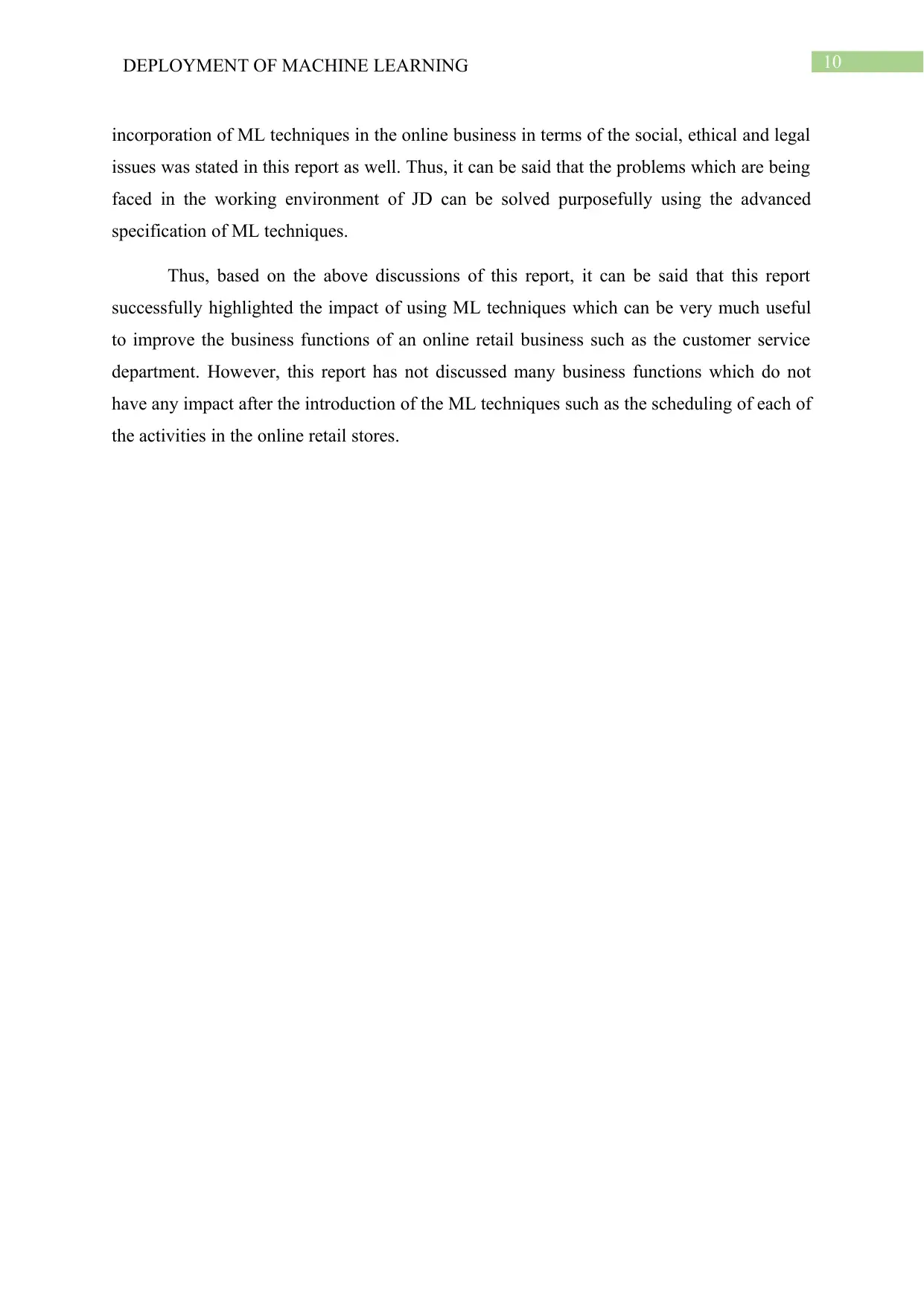
10DEPLOYMENT OF MACHINE LEARNING
incorporation of ML techniques in the online business in terms of the social, ethical and legal
issues was stated in this report as well. Thus, it can be said that the problems which are being
faced in the working environment of JD can be solved purposefully using the advanced
specification of ML techniques.
Thus, based on the above discussions of this report, it can be said that this report
successfully highlighted the impact of using ML techniques which can be very much useful
to improve the business functions of an online retail business such as the customer service
department. However, this report has not discussed many business functions which do not
have any impact after the introduction of the ML techniques such as the scheduling of each of
the activities in the online retail stores.
incorporation of ML techniques in the online business in terms of the social, ethical and legal
issues was stated in this report as well. Thus, it can be said that the problems which are being
faced in the working environment of JD can be solved purposefully using the advanced
specification of ML techniques.
Thus, based on the above discussions of this report, it can be said that this report
successfully highlighted the impact of using ML techniques which can be very much useful
to improve the business functions of an online retail business such as the customer service
department. However, this report has not discussed many business functions which do not
have any impact after the introduction of the ML techniques such as the scheduling of each of
the activities in the online retail stores.
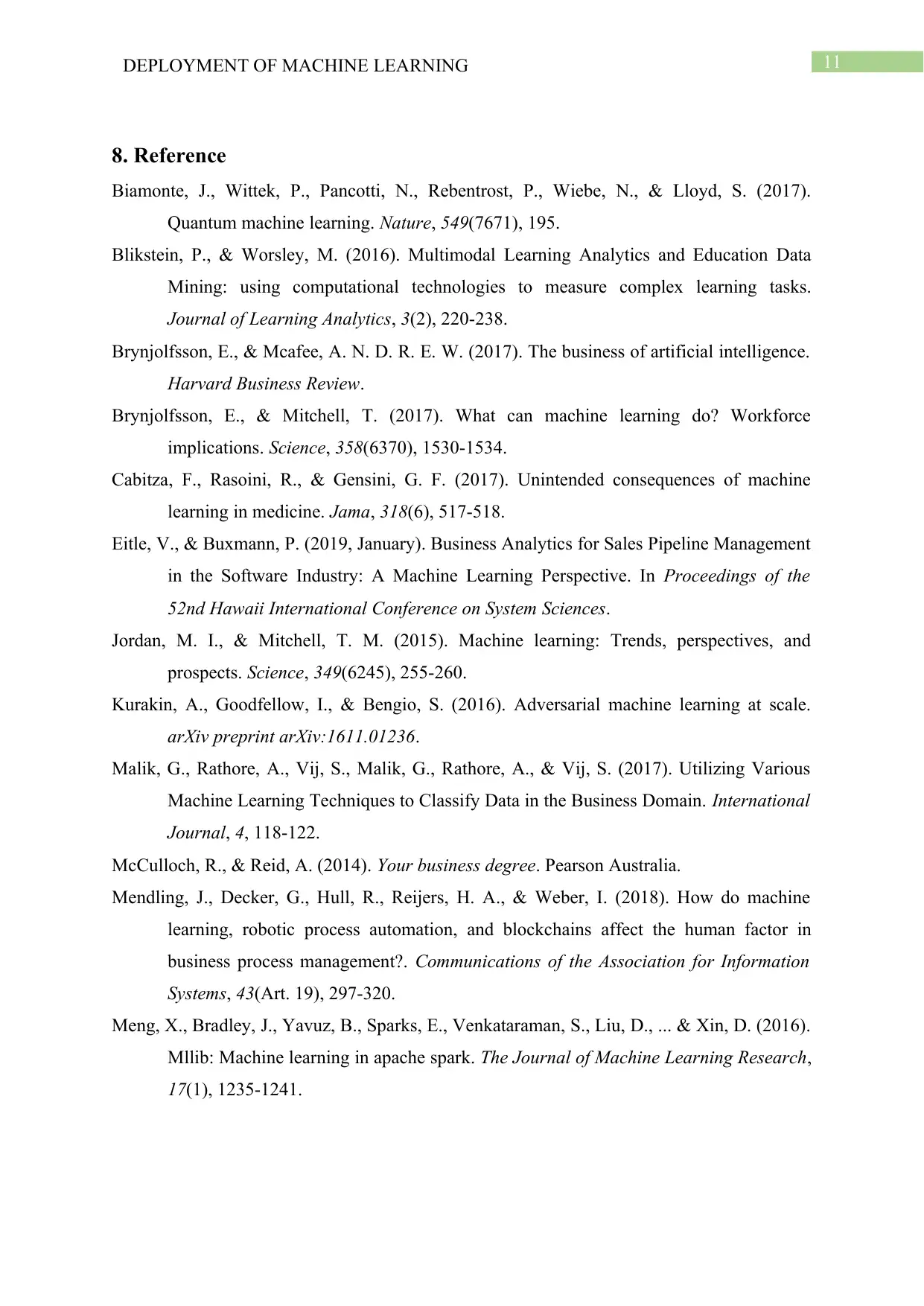
11DEPLOYMENT OF MACHINE LEARNING
8. Reference
Biamonte, J., Wittek, P., Pancotti, N., Rebentrost, P., Wiebe, N., & Lloyd, S. (2017).
Quantum machine learning. Nature, 549(7671), 195.
Blikstein, P., & Worsley, M. (2016). Multimodal Learning Analytics and Education Data
Mining: using computational technologies to measure complex learning tasks.
Journal of Learning Analytics, 3(2), 220-238.
Brynjolfsson, E., & Mcafee, A. N. D. R. E. W. (2017). The business of artificial intelligence.
Harvard Business Review.
Brynjolfsson, E., & Mitchell, T. (2017). What can machine learning do? Workforce
implications. Science, 358(6370), 1530-1534.
Cabitza, F., Rasoini, R., & Gensini, G. F. (2017). Unintended consequences of machine
learning in medicine. Jama, 318(6), 517-518.
Eitle, V., & Buxmann, P. (2019, January). Business Analytics for Sales Pipeline Management
in the Software Industry: A Machine Learning Perspective. In Proceedings of the
52nd Hawaii International Conference on System Sciences.
Jordan, M. I., & Mitchell, T. M. (2015). Machine learning: Trends, perspectives, and
prospects. Science, 349(6245), 255-260.
Kurakin, A., Goodfellow, I., & Bengio, S. (2016). Adversarial machine learning at scale.
arXiv preprint arXiv:1611.01236.
Malik, G., Rathore, A., Vij, S., Malik, G., Rathore, A., & Vij, S. (2017). Utilizing Various
Machine Learning Techniques to Classify Data in the Business Domain. International
Journal, 4, 118-122.
McCulloch, R., & Reid, A. (2014). Your business degree. Pearson Australia.
Mendling, J., Decker, G., Hull, R., Reijers, H. A., & Weber, I. (2018). How do machine
learning, robotic process automation, and blockchains affect the human factor in
business process management?. Communications of the Association for Information
Systems, 43(Art. 19), 297-320.
Meng, X., Bradley, J., Yavuz, B., Sparks, E., Venkataraman, S., Liu, D., ... & Xin, D. (2016).
Mllib: Machine learning in apache spark. The Journal of Machine Learning Research,
17(1), 1235-1241.
8. Reference
Biamonte, J., Wittek, P., Pancotti, N., Rebentrost, P., Wiebe, N., & Lloyd, S. (2017).
Quantum machine learning. Nature, 549(7671), 195.
Blikstein, P., & Worsley, M. (2016). Multimodal Learning Analytics and Education Data
Mining: using computational technologies to measure complex learning tasks.
Journal of Learning Analytics, 3(2), 220-238.
Brynjolfsson, E., & Mcafee, A. N. D. R. E. W. (2017). The business of artificial intelligence.
Harvard Business Review.
Brynjolfsson, E., & Mitchell, T. (2017). What can machine learning do? Workforce
implications. Science, 358(6370), 1530-1534.
Cabitza, F., Rasoini, R., & Gensini, G. F. (2017). Unintended consequences of machine
learning in medicine. Jama, 318(6), 517-518.
Eitle, V., & Buxmann, P. (2019, January). Business Analytics for Sales Pipeline Management
in the Software Industry: A Machine Learning Perspective. In Proceedings of the
52nd Hawaii International Conference on System Sciences.
Jordan, M. I., & Mitchell, T. M. (2015). Machine learning: Trends, perspectives, and
prospects. Science, 349(6245), 255-260.
Kurakin, A., Goodfellow, I., & Bengio, S. (2016). Adversarial machine learning at scale.
arXiv preprint arXiv:1611.01236.
Malik, G., Rathore, A., Vij, S., Malik, G., Rathore, A., & Vij, S. (2017). Utilizing Various
Machine Learning Techniques to Classify Data in the Business Domain. International
Journal, 4, 118-122.
McCulloch, R., & Reid, A. (2014). Your business degree. Pearson Australia.
Mendling, J., Decker, G., Hull, R., Reijers, H. A., & Weber, I. (2018). How do machine
learning, robotic process automation, and blockchains affect the human factor in
business process management?. Communications of the Association for Information
Systems, 43(Art. 19), 297-320.
Meng, X., Bradley, J., Yavuz, B., Sparks, E., Venkataraman, S., Liu, D., ... & Xin, D. (2016).
Mllib: Machine learning in apache spark. The Journal of Machine Learning Research,
17(1), 1235-1241.
⊘ This is a preview!⊘
Do you want full access?
Subscribe today to unlock all pages.

Trusted by 1+ million students worldwide
1 out of 13
Related Documents
Your All-in-One AI-Powered Toolkit for Academic Success.
+13062052269
info@desklib.com
Available 24*7 on WhatsApp / Email
![[object Object]](/_next/static/media/star-bottom.7253800d.svg)
Unlock your academic potential
Copyright © 2020–2025 A2Z Services. All Rights Reserved. Developed and managed by ZUCOL.




